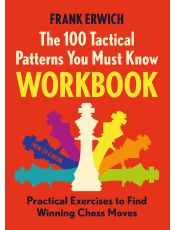Top Grandmasters Blunder Too: Lessons from 100 Tactical Patterns You Must Know
We see it happen from time to time: the best players in the world occasionally make mistakes that you wouldn't expect! Recently, the world witnessed how Ding Liren lost his world title in his final game of the World Championship match against Gukesh by blundering in a drawn endgame. Fatigue, tension, stress: these are some factors that can explain why even the best in the world sometimes overlook relatively simple moves.
In the most recent top tournament, the 2024 Champions Chess Tour Finals, we, again, saw something surprising happen. Look at what happened to Wesley So in his game against the 18-year-old Denis Lazavik: Black has just played 12…Nf6-h5, allowing a simple combination:
Black has just played 12…Nf6-h5, allowing a simple combination:
13.Nxd5!
The point is that if Black takes the knight, White traps the queen with 14.Bc7. This trick is also known as the Rubinstein Trap. It is common for openings or tactics to be named after famous players who have successfully employed them. However, in this instance, the opposite holds true. Akiba Rubinstein, one of the best chess players of his era, fell into the same trap twice within two years. First, in 1928 against future World Champion Max Euwe, and later against the reigning World Champion, Alexander Alekhine.
So played 13…Nxg3, but after 14.Nxe7+ (in-between check!) 14…Qxe7 15.hxg3, he remained a pawn down.
In 100 Tactical Patterns You Must Know, I present a diverse array of tactical themes, focusing on the specific arrangement of chess pieces, a crucial factor in executing successful tactics. Piece placement is the key to identifying what chess patterns are available in a particular position. The key information here is that the queen is hemmed in by her own pieces, and that when the c-pawn is lured away, White can trap the queen by putting the bishop on c7. I discuss this in detail in Pattern 63.
Notably, Wesley So has encountered this pattern before. In So-Mamedyarov, St Louis blitz 2018, the following position arose after White's 11.Nbd2: Focusing on typical piece configurations allows you to evaluate and decide more quickly and efficiently in certain positions. Here we see the same specific arrangement of chess pieces as in Lazavik-So. So has hemmed in his queen, and luring away the c-pawn means that …Bc2 will trap the queen. 11…Nxd4 doesn’t work here, because the knight on f3 covers d4, but there is another way to lure away the c-pawn:
Focusing on typical piece configurations allows you to evaluate and decide more quickly and efficiently in certain positions. Here we see the same specific arrangement of chess pieces as in Lazavik-So. So has hemmed in his queen, and luring away the c-pawn means that …Bc2 will trap the queen. 11…Nxd4 doesn’t work here, because the knight on f3 covers d4, but there is another way to lure away the c-pawn:
11...Nb4!
The same idea as in Lazavik-So, but in a different execution. Incidentally, Shakhriyar Mamedyarov went for the less optimal 11...Re8, and thereby did not punish So's set-up. Could this be a reason why So opted for the same unfortunate piece configuration six years later, allowing a similar trick?
Although the position looks very bad for White after the move (Black threatens both 12…Bc2 and 12…Nc2), White can limit the damage with a creative defence:
12.Rf1 Bc2 13.Qe1 Nd3 14.Bxd3 Bxd3 15.Qe5!
15.Qe5!
Black must address the counterattack on his queen.
15...Qxe5
If Black doesn’t capture the queen, White has time to move his rook away.
16.dxe5 Nd7
If 16...Bxf1? 17.exf6, then White gains a second piece for his rook as both the bishops on g7 and f1 are hanging.
17.Re1
The forced sequence of moves comes to an end. While Black holds a slight advantage, White has managed to avoid material losses and is still in contention.
For more examples with this theme, I refer you to the book.
Interestingly, in the introduction of 100 Tactical Patterns You Must Know, I also mention an example of a young So (So-Giri, Wijk aan Zee 2010), where he falls victim to a ‘basic’ pattern. And he is not the only top player this happens to, as many examples in this book show. Unfamiliarity with a specific pattern can lead to having a blind spot for the possibility of the opponent, no matter how good you are. If you haven’t seen something before (or have seen too little of it), it turns out to be very difficult to find it over the board. And this is the point I want to make. Having more specific knowledge about patterns facilitates the process of finding the right moves. Instead of struggling with different candidate moves, the specific positions of the pieces can immediately tell you what you can and cannot do in a given position.
So (!), get started with 100 Tactical Patterns You Must Know, practice with The 100 Tactical Patterns You Must Know Workbook, and who knows, you might soon defeat a grandmaster because you possess crucial knowledge and skills!

